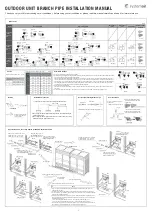
Installation and operation manual
32
10T8Y1B
VRV-W IV System Air Conditioner
4P399208-1 – 2015.01
When selecting indoor units, the connection ratio (CR) has to be kept
within limitations: 50%
≤
CR
≤
130%.
More detailed information can be found in the technical engineering
data.
16.4. Method for adding refrigerant
Be sure to charge the specified amount of refrigerant in liquid state.
Since this refrigerant is a mixed refrigerant, adding it in gas form may
cause the refrigerant composition to change, preventing normal
operation.
1.
Before charging, check whether the refrigerant cylinder is
equipped with a siphon tube or not.
2.
Be sure to use tools exclusively for R410A to ensure required
pressure resistance and to prevent foreign materials from mixing
into the system.
A. Additional refrigerant charge procedure by normal way
3.
After the vacuming drying is finished, charge the additional
refrigerant in liquid state through the stop valve service port.
Check if gas and liquid stop valves are closed.
If the total amount can not be charged, follow the additional
refrigerant charge procedure (B) shown below.
Heat pump system (2-pipe)
Heat recovery system (3-pipe)
1
Pressure reducing valve
2
Nitrogen
3
Charge hose
4
Refrigerant R410A tank (siphon system)
5
Measuring instrument
6
Vacuum pump
7
Outdoor unit
8
Gas line stop valve
9
Liquid line stop valve (in case of heat pump system): HP/
LP
10
HP/LP gas line stop valve
11
Suction gas line stop valve (in case of heat recovery
system)
12
Stop valve service port (in case of heat recovery system)
13
To indoor unit
14
To indoor unit/BS unit
15
Field piping
A
Valve A
B
Valve B
C
Valve C
D
Valve D
B. Additional refrigerant charge procedure by additional
refrigerant charge operation
Refer to
page 35
for more information about the system settings for
additional refrigerant charge operation.
1
Turn on the power supply of the system (indoor and outdoor
unit(s)).
2
Make sure the pump is operational and water circulation is
possible.
3
Open the valves in accordance with the below table.
22.2
0.37
22
0.35
Charge the liquid
refrigerant with the
cylinder in upright
position.
Charge the liquid
refrigerant with the
cylinder in upside-down
position.
NOTICE
Charging with an unsuitable substance may cause
explosions and accidents, so always make sure that the
appropriate refrigerant (R410A) is charged. Refrigerant
containers must be opened slowly.
CAUTION
When charging a system, charging over the
permissible quantity can cause liquid hammer.
Always use protective gloves and protect your eyes
when charging refrigerant.
When the refrigerant charging procedure is done or
when pausing, close the valve of the refrigerant tank
immediately. If the tank is left with the valve open, the
amount of refrigerant which is properly charged may
get off point. More refrigerant may be charged by any
remaining pressure after the unit has stopped.
NOTICE
If the power of some units is turned off, the charging
procedure cannot be finished properly.
In case of a multi outdoor unit system, turn on the
power of all outdoor units.
Make sure to turn ON the power 6 hours before
starting the operation. This is necessary to warm the
crankcase by the electric heater.
If operation is performed within 12 minutes after the
indoor and outdoor units are turned on, the
compressor will not operate before the
communication is established in a correct way
between outdoor unit(s) and indoor units.
Before starting charging procedures, check if the LED
indication on the outdoor unit A1P PCB is as normal
(see
"15.2. Operating the push buttons and DIP
switches on the logic board" on page 29
). If a
malfunction code is present, see
"18.2. Malfunction
code list" on page 41
.
Make sure all connected indoor units are recognised
(see
"17.2. Monitoring function and field settings" on
page 33
).
Inch piping size
(Ø) (mm)
Weight factor
Metric piping
size (Ø) (mm)
Weight factor
NOTICE
In case of maintenance and the system (outdoor unit+field
indoor units) does not contain any refrigerant any
more (e.g., after refrigerant reclaim operation), the unit has
to be charged with its original amount of refrigerant (refer
to the nameplate on the unit) by pre-charging before the
automatic charging function can be started.
Which valves?
State of valves
State of valves A, B, C and D and
stop valves
Valve A
Open
Valve B
Closed
Valve C
Open
Valve D
Closed
1
8
2
4
5
R410A
6
13
7
7
9
12
15
A
B
C
3
1
2
4
5
R410A
10
6
7
7
14
9
11
12
15
A
B
C
D
















































